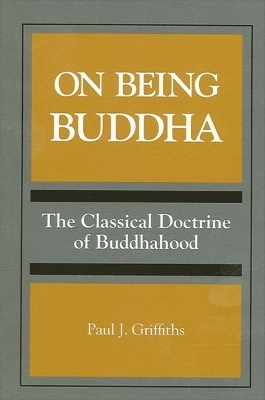
On Being Buddha
State University of New York Press (Verlag)
978-0-7914-2128-4 (ISBN)
The book shows that Buddhist thinkers were driven, when theorizing about Buddha, by a basic intuition that Buddha must be maximally perfect, and that pursuing the implications of this intuition led them into some conceptual dilemmas that show considerable similarity to some of those treated by western theists. The Indian Buddhist tradition of thought about these matters is presented here as thoroughly systematic, analytical, and doctrinal.
The book's analysis is based almost entirely upon original sources in their original languages. All extracts discussed are translated into English and the book is accessible to nonspecialists, while still treating material that has not been much discussed by western scholars.
Paul J. Griffiths is Associate Professor in the Divinity School and in the Department of South Asian Languages and Civilizations at the University of Chicago. He has previously published books on Buddhist philosophy (On Being Mindless and The Realm of Awakening) and on cross-cultural philosophy and theology (An Apology for Apologetics).
Foreword
by Frank E. Reynolds
Preface
Acknowledgments
Chapter One: The Doctrinal Study of Doctrine
1.0 Prolegomena
1.1 Primary Doctrines
1.2 Secondary Doctrines
1.2.1 Rules of Recognition and Patterns of Derivation
1.2.2 Rules of Interpretation and Combination
1.3 The Doctrinal Uses of Primary Doctrines
1.4 Applying the Theory
Chapter Two: Buddhist Doctrine
2.0 Prolegomena
2.1 The Doctrinal Digests
2.2 The Authority of the Doctrinal Digests
2.3 The Content and Subject-Matter of the DoctrinalDigests
2.4 The Goals of the Doctrinal Digests
2.5 Theories of Doctrine in the Doctrinal Digests
2.5.1 Rules of Recognition
2.5.2 Rules of Interpretation
Chapter Three: Buddhalogical Doctrine
3.0 Prolegomena
3.1 Buddhalogy and Maximal Greatness
3.2 Titles and Epithets of Buddha
3.3 Properties of Buddha
3.4 Analytical and Organizational Schemata
3.5 Metaphysical Embeddedness and Systematic Location
Chapter Four: Buddha in the World
4.0 Prolegomena
4.1 The Buddha-Legend
4.2 Bodies of Magical Transformation
4.3 Buddha's Perfections of Appearance in the World
4.4 Buddha's Perfections of Action in the World
4.4.1 Spontaneity and Effortlessness
4.4.2 Endlessness and Omnipresence
4.4.3 Excursus: Buddha's Consumption of Food
4.5 Buddha's Perfections of Cognition in the World
4.5.1 0mnilinguality
4.5.2 Awareness of What Is Possible and What Is Impossible
4.6 One Body of Magical Transformation at a Time? A Controversy
Chapter Five: Buddha in Heaven
5.0 Prolegomena
5.1 Ornamenting Heaven
5.2 Bodies of Communal Enjoyment
Chapter Six: Buddha in Eternity
6.0 Prolegomena
6.1 Epistemic Predicates
6.1.1 Awareness Simpliciter
6.1.2 Buddha's Awareness
6.2 Metaphysical Predicates
Chapter Seven: Doctrinal Criticism
Doctrinal Criticism
Notes
Glossary
Bibliography
Index
| Erscheint lt. Verlag | 8.9.1994 |
|---|---|
| Reihe/Serie | SUNY series, Toward a Comparative Philosophy of Religions |
| Zusatzinfo | Total Illustrations: 0 |
| Verlagsort | Albany, NY |
| Sprache | englisch |
| Maße | 152 x 229 mm |
| Gewicht | 399 g |
| Themenwelt | Geisteswissenschaften ► Religion / Theologie ► Buddhismus |
| ISBN-10 | 0-7914-2128-7 / 0791421287 |
| ISBN-13 | 978-0-7914-2128-4 / 9780791421284 |
| Zustand | Neuware |
| Haben Sie eine Frage zum Produkt? |
aus dem Bereich


